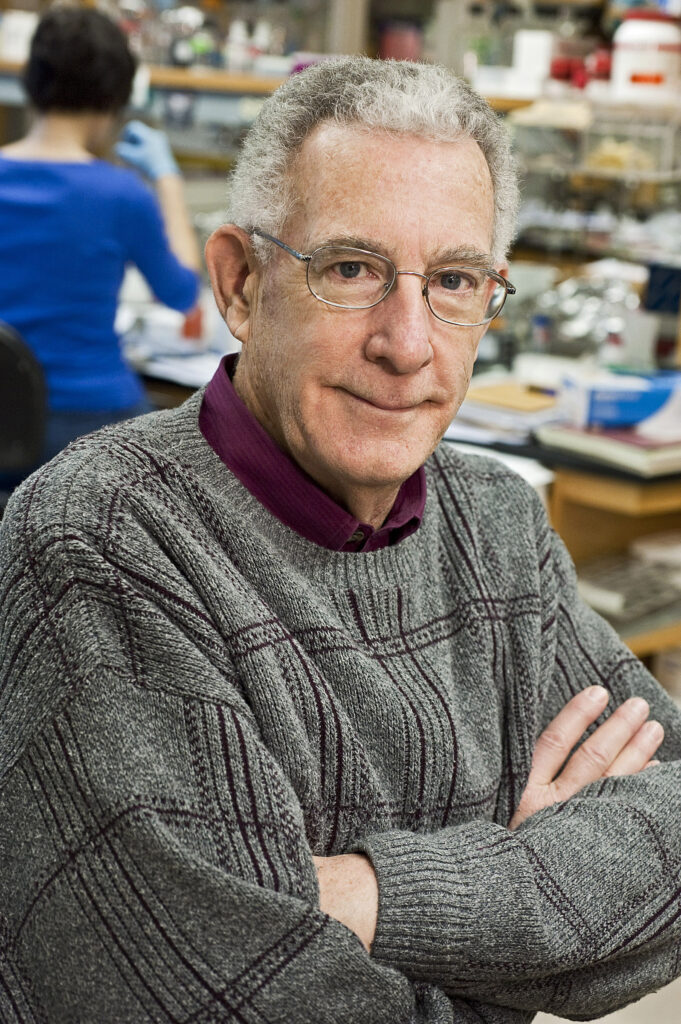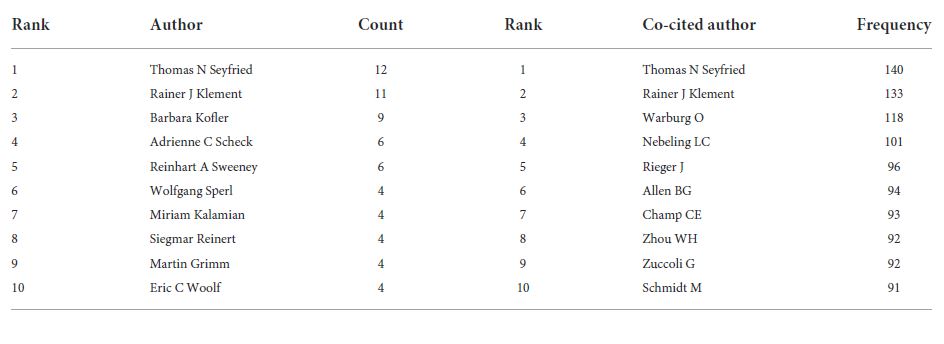The following interview is an extract from my book "KREBS – verstehen, vermeiden und ganzheitlich behandeln", which is going to appear soon. The book contains a total of twelve such interviews with renowned therapists, physicians and researchers.

Thomas N. Seyfried ist Professor für Biologie am Boston College im US Bundesstaat Massachusetts; er promovierte 1976 in Genetik und Biochemie an der Illinois Universität in der Stadt Urbana.
He did his undergraduate work at the University of New England where he recently received the distinguished Alumni Achievement Award. He also holds a Master's degree in Genetics from Illinois State University, Normal, IL. Thomas Seyfried served with distinction in the United States Army’s First Cavalry Division during the Vietnam War, and received numerous medals and commendations. He was a Postdoctoral Fellow in the Department of Neurology at the Yale University School of Medicine, and then served on the faculty as an Assistant Professor in Neurology. Other awards and honors have come from such diverse organizations as the American Oil Chemists Society, the National Institutes of Health, The American Society for Neurochemistry, and the Ketogenic Diet Special Interest Group of the American Epilepsy Society. Dr. Seyfried previously served as Chair, Scientific Advisory Committee for the National Tay-Sachs and Allied Diseases Association. He has received Lifetime Achievement Awards from the Academy of Complimentary and Integrative Medicine, the International Dose Response Society, and the Uncompromising Science Award from the American College of Nutrition for his work on cancer. He presently serves on several editorial boards, including those for Nutrition & Metabolism, Neurochemical Research, the Journal of Lipid Research, and ASN Neuro, where his is a Senior Editor. Dr. Seyfried has over 200 peer-reviewed publications and is author of the book Cancer as a Metabolic Disease: On the Origin, Management, and Prevention of Cancer (Wiley Press). His book was recently translated into Chinese and is now under contract for translation into Turkish. He has described his research on many podcasts and radio shows and his work is central to the documentary film, The Cancer RevolutionDr. Seyfried’s full list of peer-reviewed publications can be found on PubMed (https://pubmed.ncbi.nlm.nih.gov).
Dear Tom, 100 years ago Otto Warburg published his pioneering work on tumor cell metabolism, showing that basically all aggressive tumors exhibit high glucose consumption and release of lactate. When and why did you become interested in Otto Warburg’s work?
When I started to collect research on the therapeutic effects of calorie restriction and calorie restricted ketogenic diets against preclinical brain tumors. We found that the therapeutic effect of these treatments was linked directly to reduced blood glucose and elevated ketones bodies. Warburg showed evidence that all cancers upregulate the aerobic fermentation of glucose as a consequence of deficient oxidative phosphorylation (respiration). We also found that all major cancers have abnormalities in the number, structure, and function of their mitochondria thus directly supporting Warburg’s findings. Warburg was absolutely correct in defining cancer as a disorder of mitochondrial function. We are now correcting some of the misinformation associated with Warburg’s findings and providing new information not known to Warburg that further supports the new mitochondrial metabolic theory of cancer.
Can you name and briefly explain some of this misinformation associated with Warburg's findings?
Here are the corrections to Warburg's misunderstanding on the origin of ATP synthesis in cancer cells.
1. Warburg used lactic acid production as a marker for ATP synthesis through glycolysis in cancer cells. He assumed that 1 mol of lactate was equal to 1 mol of ATP produced. He was unaware that many cancer cells express high levels of the PKM2 isoform, which does not produce ATP through the kinase reaction in glycolysis as does the PKM1 isoform. Consequently, a considerable amount of lactate is produced in cancer cells independent of ATP synthesis. It is especially difficult to estimate ATP production through glycolysis in tumor cells that contain a mixture of PKM2 & PKM1 isoforms. Hence, Warburg was incorrect in using lactate production as a measure of ATP synthesis through glycolysis.
2. Warburg also assumed that oxygen consumption in tumor cells was completely linked to ATP synthesis through OxPhos. He estimated that 1 mol of oxygen consumed produced 7 mols of ATP through OxPhos. Although oxygen consumption is linked to ATP synthesis in normal cells and tissues, newer information from several studies now shows that oxygen consumption is not linked completely to ATP synthesis through OxPhos in cancer cells. Most of the oxygen consumption in cancer cells is linked to ROS production and to other oxygen consuming reactions that are independent from OxPhos. Hence, Warburg was incorrect in using oxygen consumption as an accurate measure of ATP synthesis through OxPhos in cancer cells.
3. Finally, Warburg was unaware of glutamine-derived ATP synthesis through mitochondrial substrate level phosphorylation at the succinyl CoA step in the glutaminolysis pathway. ATP synthesis through glutaminolysis can compensate for insufficient ATP synthesis from either OxPhos or glycolysis. Both Warburg and his chief critic, Sidney Weinhouse, were unaware of glutamine fermentation a major source of ATP synthesis in cancer cells. Consequently, the arguments between Warburg and Weinhouse regarding ATP synthesis calculations based on the Meyerhof quotient become inconsequential.
Warburg was absolutely correct in defining cancer as a disorder of mitochondrial energy metabolism with a compensatory fermentation necessary for ATP synthesis. He simply mistook lactic acid and oxygen consumption as accurate readouts for ATP synthesis through glycolysis and OxPhos, respectively. As information on ATP synthesis through mitochondrial substrate level phosphorylation was not well known at that time, Warburg was unaware of this second fermentation pathway that could produce ATP in the absence of oxygen, OxPhos, and glycolysis. Warburg was correct in stating that aerobic fermentation compensates for insufficient OxPhos.
Cancer has become a pandemic in modern societies. Which are the top risk factors for developing cancer? Is eating meat a risk factor?
Diet & lifestyle is the top risk factor for developing cancer. Consumption of highly processed high-carbohydrate foods in the absence of adequate daily exercise are the major risk factors for most chronic diseases including cancer, cardiovascular disease, Type 2 diabetes, obesity, and dementia among others. Obesity is now replacing smoking as a major risk factor for cancer.
The consumption of natural meats is not a risk factor for cancer. Our Paleolithic ancestors survived largely on meat diets, as described in your article. Cancer is extremely rare in aboriginal tribes that live according to their ancestral ways. We would not exist as a species today if not for meat consumption during our evolutionary past. Few carbohydrates are found in meat. Our biology is supremely designed for consumption of meats.
Can you briefly describe what the major changes are occurring during the transition from a normal to a cancer cell?
Any number of chronic insults to our tissues that would damage mitochondrial oxidative phosphorylation can transition a normal cell into a cancer cell. These insults could include chronic inflammation, intermittent hypoxia, and exposure to carcinogens or radiation, infection from oncogenic viruses, rare inherited mutations, and age. Mitochondrial function controls the differentiated state and the cell cycle. The gradual replacement of ATP synthesis through oxidative phosphorylation with ATP synthesis through fermentation leads to dedifferentiation and dysregulated cell growth. Dysregulated cell growth is the official definition of cancer.
Gibt es Deiner Erfahrung nach einen relativen Unterschied zwischen Glukose und Glutamin hinsichtlich der Wichigkeit für Tumorzellen und falls ja, von welchen Faktoren hängt dieser ab?
Both fuels are necessary and sufficient for the viability and growth of most, if not all, cancer cells. Glucose carbons fuel the glycolysis and pentose phosphate pathways necessary for biomass synthesis while glutamine fuels the glutaminolysis pathway and provides nitrogen for DNA, RNA, and protein synthesis. Both fuels can also support ATP synthesis through substrate level phosphorylation in the cytoplasm and the mitochondria, respectively. We have not yet found a tumor cell that can survive for very long in the absence of glucose and glutamine nor have we found any sugar, fat, or amino acid that can replace either glucose or glutamine for tumor cell survival.
Can you briefly explain your recommended treatment protocol for cancer patients?
We use the press-pulse therapeutic strategy for restricting the availability for glucose and glutamine to the tumor cells. Tumor cells cannot use either fatty acids or ketone bodies for survival in the absence of glucose and glutamine. Consequently, the simplest and most parsimonious strategy for managing cancer under the mitochondrial metabolic theory is to restrict availability of glucose and glutamine while placing the whole body in a state of nutritional ketosis.
In your opinion, what are the main reasons why metabolic therapies have not yet found their way into the clinic and even are advised against by many oncologists?
Most oncologists do not support metabolic therapy due to a profound lack of knowledge on the biology of cancer and to an intense desire in maintaining the status quo.
I also heard you talk about the human body having enormous healing powers and that prayers might optimize this process. Can you elaborate on that?
The human body can heal itself if given the opportunity. Food restriction has healing power across most mammalian species. Humans appear to be the only mammalian species that continues to eat when diseased or injured. Water-only fasting has long been known to have healing power, but this practice is difficult for many people. Prayer has the power for maintaining the discipline needed for water-only fasting.
I joyfully remember our trip to a pub in Tampa, Florida in 2017 where we had some beer, wine or other drinks (somehow I forgot the details…). It seems we both share the view that if someone is healthy there is no need to be over-strict with diet and other lifestyle choices, and that social interactions are very important. What would be your top 5-10 advices for healthy people to live a long, healthy and joyful life?
These are only suggestions:
1. Continue to work as long as you can and as long as you enjoy the work.
2. Maintain social interactions.
3. Continue to maintain body weight in a healthy BMI range.
4. Exercise daily to maintain good cardiovascular function.
5. Most importantly, try to avoid eating ultra-processed high-carbohydrate foods.


